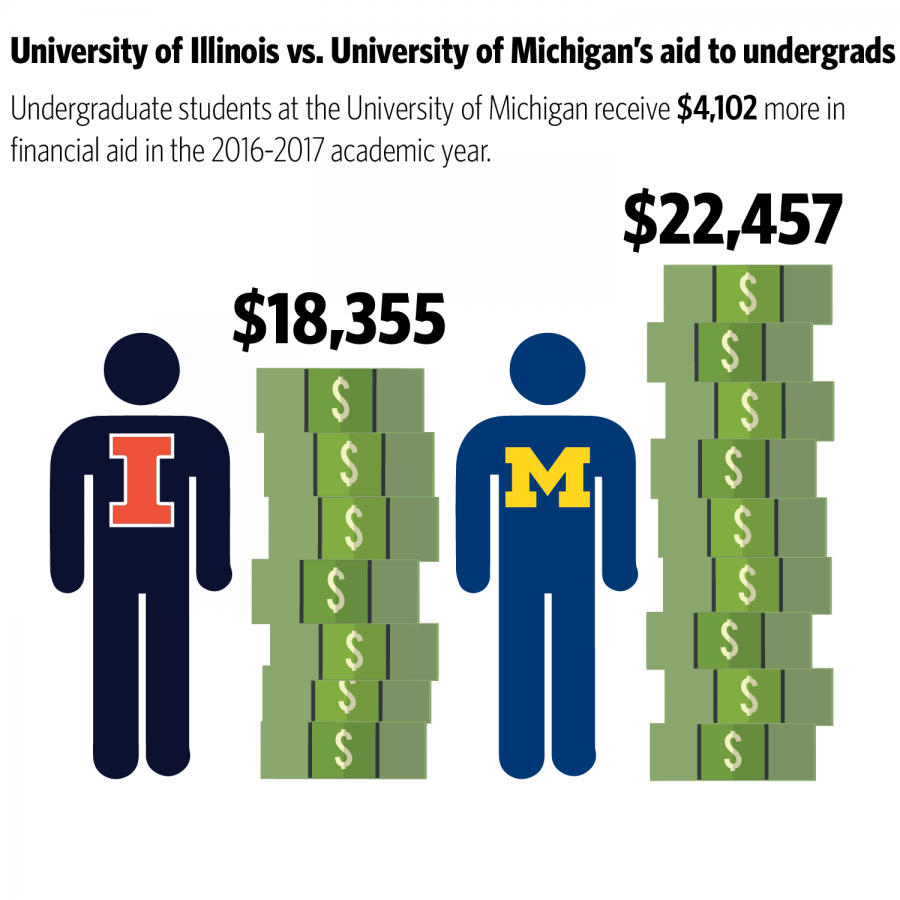University striving for better tuition deals similar to ‘Go Blue Guarantee’
Source: Office of Financial Aid
Feb 8, 2018
As of January, the University of Michigan Go Blue Guarantee grants free tuition to any in-state family receiving an annual income of $65,000 and below. University Vice Provost Kevin Pitts said the University is looking into doing something similar to Michigan’s Go Blue Guarantee and is currently configuring a plan to do so.
“The chancellor and the provost are very supportive of this, and they completely recognize that the cost of attendance that the financial pressure that college can put on students is really important,” Pitts said.
Pitts said he believes there are two parts to the financial aid system. One piece of it is how much financial aid they are offering to students, which students can apply for from the federal government, the state of Illinois, MAP grants and through the University itself.
This year, the University has put in more than $85 million into support for students, Pitts said. However, the financial need on this campus equates to around $100 million, leaving about $15 million of unmet need.
Pitts refers to the other part of the system as a marketing piece, meaning how the University helps students, especially prospective students, understand there is money available for students with need-based aid.
Get The Daily Illini in your inbox!
“(The University of Michigan) is actually not putting that much more money into academic support or scholarship support than they did before,” Pitts said. “But they’re helping students better understand what’s out there by giving them a clear picture.”
He added the University awards high-achieving high school students, generally providing them with merit-based aid. Pitts said all financial need not met by the government or institution is taken from student loans, which eventually leads students to graduate with debt.
On average, a student at the University will graduate with $26,000 of debt, Pitts said.
“Scholarships are a big focal point there because we know we need to raise more money to help students and both be able to finish their degree and not graduate with a crushing amount of student loan debt,” Pitts said.
He said the University is currently looking to try and raise more scholarship money with a big fundraising campaign.
Gus Wood, co-president of Graduate Employees’ Organization, said he doesn’t think the University will do a similar program as Michigan’s unless the students ask for the help — which he advises people to do.
“We should call for any program that takes away any burden of financial debt from trying to go to school, something that everybody should have a freedom to do, no matter what your socioeconomic status is,” Wood said.
Wood’s plan to help push for restored financial assistance is for students to organize and to start calling for change from the University.
“We take this program. We look at the benefits and negatives of it. We analyze it and then we pressure the University to implement something like this,” Wood said about Michigan’s Go Blue Guarantee.
Pitts said the University is aware that paying for a college degree is difficult, expensive and considered a major investment. He said they’re doing everything they can to make the University more affordable and to try and provide as much possible financial support.
“We’re doing everything we can to help, and we want students to remember that the investment that their families and they are making in themselves is an investment that’s going to pay off,” Pitts said.






